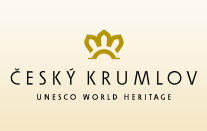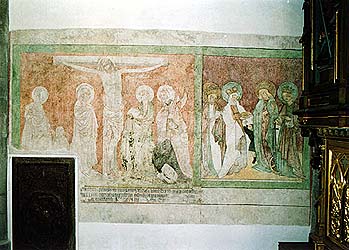St. Vitus Church in Český Krumlov
 MP3 (101
kB), Real
Audio (127 kB), WAV
(1,12 MB)
MP3 (101
kB), Real
Audio (127 kB), WAV
(1,12 MB)
Location
Two main dominants define the skyline of the Český Krumlov town.
The castle tower symbolizes the secular ruling power and the region
of its influence; the church tower of St. Vitus then personifies
the might of the holy Christendom which from medieval times
functioned both as a counterpart and complement of the wordly
powers. The church shares with the castle the promontory created by
the river Vltava, thus creating an impressive architectural feature
that characterizes the town.

|
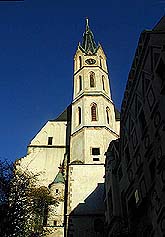
|
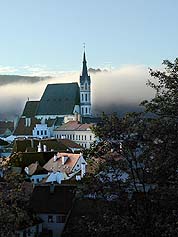
|
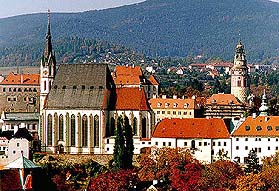
|
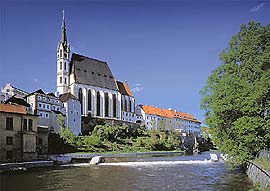
|
Description of the Building The
St. Vitus Church is built in the form of three parallel arcades
merged with a five-sided elongated presbyterium, there are
rectangular multistoried sacristies on both sides with the Chapels
of Resurrection and the St. John of Nepomuk Chapel, and the
antechamber situated on the northern side. The occidental facade of
the church incorporates a tower with quadrangular Roman window
openings on the landing level changing to eight-sided openings
higher up. The uppermost part of the spire is pseudogothic in
style, dating to 1893-1894 A.D.
The
St. Vitus Church is built in the form of three parallel arcades
merged with a five-sided elongated presbyterium, there are
rectangular multistoried sacristies on both sides with the Chapels
of Resurrection and the St. John of Nepomuk Chapel, and the
antechamber situated on the northern side. The occidental facade of
the church incorporates a tower with quadrangular Roman window
openings on the landing level changing to eight-sided openings
higher up. The uppermost part of the spire is pseudogothic in
style, dating to 1893-1894 A.D.
History of the Construction
The Parish of Český Krumlov was likely established by Peter
I von Rosenberg shortly before 1317 A.D., while the first
written evidence dates back to 1329. Originally built as a small
church, it lacked the capacity to serve the needs of the growing
population of the capital residential town of the Rosenbergs.
Therefore, on a spur of the same Peter von Rosenberg, a building of
larger proportion was begun.

|

|
The actual work on the new building started under the directives of the German builder Linhart of Aldenberg, memorized to this day by the lettering in the emblem situated in the main dome ceiling. A local building master Stanek of Český Krumlov then carried out the extension of the church in the form of three parallel hallways.
In the year 1390, the ruler of Rosenberg became Heinrich III of Rosenberg. This pious but ambitious nobleman decided to carry out the reconstruction of the St. Vitus Church in a very magnanimous style. In the year 1407, the vicar of Český Krumlov, Hostislav von Bilsko entered into agreement with the building master Jan Staněk, a nephew of the late Staněk of Krumlov, to built a dome over the main church hall in the style of St. Jiljí Church in Milevsko, i.e. over eight round pillars. The said agreement contains a detailed list of tasks that were outlined to the said Master Jan, thus we have a comparatively accurate perception of what the dome ceiling and the arched arcades should have looked like. It is significant to note the agreement with the existing dome structure. There is an accurate count of ties - 23 located in the webbing of the presbyterium ceiling, 15 in the old sacristy, 2 in the room situated above it, 30 in the main dome, and 5 in the cross-tied ceiling of the southern as well as in the northern archway. In the presbyterium and in the main hall of the church, there is a web like ceiling in the "parlerian" style that reminisces the Royal Cathedral of St. Vitus situated in Prague. The web ceiling was built from cut stone, while the simpler cross-tied ceiling, used over the lesser halls, is made of brick. The eight pillars are still in the church but they are not rotund. Four of them are in the eight-sided cross section, and the other four in the gothic four-leaf form.

|

|
Five windows break the southern wall of the church. In the northern wall there were originally four windows. The window closest to the presbyterium is preserved in full; the other was significantly shortened up in the years 1724-1726 on account of the newly built chapel of St. John of Nepomuk. The third window disappeared by the end of 15th century during the building of the Resurrection Chapel. Only the fourth window was kept in the original shape.
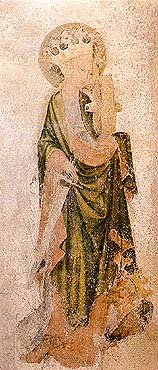 The height of the side
colonnades approximates that of the main hall, a feature which
classifies the St. Vitus church as a church of the hall type. The
east to west length of the church is 44 meters, ie. 125 feet. It is
about 20 m wide and 20 m high.
The height of the side
colonnades approximates that of the main hall, a feature which
classifies the St. Vitus church as a church of the hall type. The
east to west length of the church is 44 meters, ie. 125 feet. It is
about 20 m wide and 20 m high.
The building of the church was time-consuming proposition, financed in large part even through public collections supported among others even by the Archbishop of Prague Zbyněk Zajíc of Hasenberg. It was completed after the Hussite Wars. The consecration of the church in the year 1439 by bishop of Passau Nicolas was likely done before the completion of the building reconstruction. There was no more significant reconstruction of the church structure, only in the 19th century the onion-shaped Baroque tower was replaced by an eight sided pseudogothic tower (1893-1894).
The interior and the church inventory are also neogothic. The main altar has a painting of St. Vitus and the Virgin Mary dating to 1673-1683, with ties to the period of Jesuit influence in Český Krumlov. This painting was repainted over by Jan Krejčík in 1897. There were a number of side altars in the church until 1780 A.D. A creation of a side altar was in a way an expression of the "artisan pride", as the cost of creating it was often covered by individual craft brotherhoods living in the town. For example, there was an altar of tailors, shoemakers, butchers, bakers of white or dark breads, stone masons, cooks and of course, a brotherhood of brewmasters.
The side altars are neogothic. Now we find an altar of František Xaverský (left side), altar of Virgin Mary, St. Wenceslaus altar, and St. Florian's altar.

|

|
From the left side of the left colonnade, we can look into the chapel of St. John of Nepomuk. Near the entrance to the chapel, there are two gravestones made of red marble originating in the former sepulchre of Wilhelm von Rosenberg (died in 1592 A.D., aged 58) and his third wife Anna Maria Rosenberg, geb. von Baden (died in 1582 A.D., aged 21 years). (see Old Tombstones in Český Krumlov).

|

|
The foundation for the Rosenberg's mausoleum was laid in the year 1583, when the remains of Anna Maria of Baden were entombed there. From the existing accounts it could be that the "cellar", i.e. the crypt was built by a mason Honza Koš from Český Krumlov. On 10th of December 1592, the bodily remains of Wilhelm von Rosenberg were also entombed there. A grave monument of Wilhelm von Rosenberg, together with the main altar crowned at the very top by a statue of the Rosenberg rider, was ordered by his brother Peter Wok of Rosenberg to be originally placed in the church presbyterium.
Following the death of Peter Wok in 1611, several changes took place in the chapel interior. The first victim of the change was specifically the Rosenberg Rider, removed (quoting the words of the Chronicle written by Vaclav Brezina) - "...after times the Jesuits, discussing that he might perhaps jump down and trod on them, had him cut down." Ten years later, the then rector of the Jesuit College in Český Krumlov, Albrecht Chanovsky of Dlouha Ves, caused the vault contents of the sepulchre tiled with red marble to be removed. This intrusion into the tomb of Wilhelm von Rosenberg with Anna Maria Baden was met with an outburst of protests and passionate refutal of the still living widow of Wilhelm von Rosenberg, Polyxena of Pernstein Lobkovitz (after second husband), as well as the anger of Jan III. Lohelius, Archbishop of Prague. They eventually won in having the mausoleum reestablished in its original form.
In 1670, the Český Krumlov Diocese initiated the creation of a new main altar. The work began with removal of the terracota statues from the era of Peter Wok von Rosenberg. This action spurred a disagreement from Johann Christian I. von Eggenberg, at that time the ruler of the Český Krumlov region. This magnate considered himself a decisive factor in all things concerning his estate and the vassal town of Český Krumlov. The College and the prelates were accused of deliberate destruction of an artwork without the magnate's prior approval, destruction of something they did not create and that is de facto a princely heritage left by the Rosenbergs. The negotiations ensued between both parties concerning the main altar enhancement until 1683.
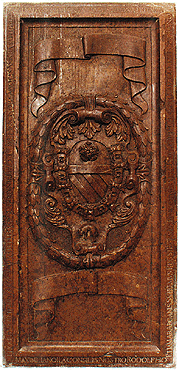
|
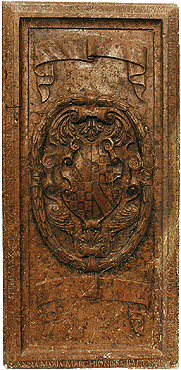
|
The problem of the Rosenbergs' crypt, often called a mausoleum, was supposedly resolved in the years 1717-1718. In December 1717, the then Český Krumlov prelate Heubel asked the Countess Maria Ernestine von Eggenberg for a permit to disassemble the mausoleum. He argued that the mausoleum in its original place is an obstacle lying only a few steps away from the main altar in the centre of the presbyterium. The prelate attached a plan of the presbyterium in the St. Vitus Church; it is now the only preserved document which accurately describes the position of the Rosenberg crypt. The vault was about 5 Prague feet (circa 150 cm) from the main altar steps in the centre of presbyterium, then about 4 feet (120 cm) further was a stone anchored in the ground. The stone had four disks hiding the entrance to the tomb. Right next to it a smaller stone was laid in the ground; this one is referred to in the plan as the one bearing five roses and writings along its circumference.
 Maria Ernestine passed
away in 1719, Český Krumlov obtained a new ruler, and the whole
affair was postponed.
Maria Ernestine passed
away in 1719, Český Krumlov obtained a new ruler, and the whole
affair was postponed.
The final permission to remove the mausoleum was obtained from the Diocese and Jan of Nepomuk Schwarzenberg in 1783. It was not restricted to the removal of the gravestone but included removal of the crypt as well. The registrar of Count Melchior Franck reports, and we have learned, that the mausoleum was located in the middle of the choir, and the core was made of a hollow brick chamber adorned by tiles of rare red marble. It was 6 feet long by 3 feet wide and 4 feet in height (190 cm by 95 cm wide and 127 cm high). On the top of the tomb were two marble plates 5 feet 3 inches long (198 cm) and 3 feet 3 inches wide (103 cm). The right plate had a Rosenberg Coat of Arms emblem in the middle, and the left plate bore the emblem of Baden.
Franck further describes the crypt below the mausoleum, where four coffins were found. On the right hand side of the entrance was a metal coffin resting on three stone quadrates. This coffin containing the remains of Wilhelm of Rosenberg was 7 feet 6 inches long (237 cm), 2 feet 7 inches (82 cm) wide, and 1 foot 11 inches high (61 cm). Two metal plates were attached to the coffin, one listing all of Wilhelm's titles and offices. The other, below the first, had the Rosenberg emblem embossed on it with a picture of the Golden Fleece Order and the date 1592 A.D. The lid of the coffin bore a metal crucifix. The actual order of the Golden Fleece was found inside the coffin and given to the abbot of the Vyšší Brod monastery for safekeeping. Today it is owned by the numismatic section of the National Museum in Prague and is exhibited in the Lobkowitz palace. In accordance with the Rosenberg accounts there was also a sword in the coffin.
The remains of Anna Maria Rosenberg of Baden were in a coffin situated on the left side of Wilhelm's coffin. It was made in 1583 by the bell maker Brikci of Cinberg using 7 "centnyr" mass of metal (432 kg). In Franck's opinion, it was more beautiful than Wilhelm's coffin. The casket was 5 feet 3 inches long (198 cm), 1 foot 11.5 inches (69 cm) wide and 1 foot 4.5 inches (43.5 cm) high. On the cover was a metal crucifix situated in the middle, on the right side was a Rosenberg badge with the lettering WZR and the date 1583, and on the left the Baden emblem with embossed letters AMMZB and the same date. Both sides of the casket had handles; miniature angel heads and miscellaneous Baden insignia adorned the four corners of the coffin. A plaque was also attached to the coffin with an extensive text written in Czech giving basic information about the personage of Wilhelm von Rosenberg and an announcement of Anna Maria's death.
Further in the crypt was a wooden casket of Maria Johanna of the Dutch branch of the Schwarzenberg family. She died suddenly in 1670 A.D. while visiting her relative Maria Ernestine of Eggenberg, née Schwarzenberg in Český Krumlov. The fourth casket, smaller than the others and also made of wood, contained the remains of a year old child Franz Josef, a son of Josef Adam of Schwarzenberg; he passed away in 1750 A.D.
Both wooden coffins were left in the crypt while the other metal coffins were taken away, their contents placed in new oak caskets, and later returned to the crypt. The total mass of the metal coffins was noted at 999 pounds (559.5 kg). On the 6th of September 1785, these were sold away in the old metal auction.
Following the mausoleum disassembly, the question remained what to do with the two marble cover plates. Josef Adam of Schwarzenberg originally proposed that these be placed into the crypt with the rest, but there was not enough space. Finally, they were inlaid into the walls on the sides of the entrance into the St. John of Nepomuk chapel where they can be found even today.
 The remaining members of
the Rosenberg family are buried in the Vyšší Brod Monastery;
apparently their crypt has not yet been tampered with. Legend says
that the abbot causing the crypt to be opened will die the same
year.
The remaining members of
the Rosenberg family are buried in the Vyšší Brod Monastery;
apparently their crypt has not yet been tampered with. Legend says
that the abbot causing the crypt to be opened will die the same
year.
The altar in the St. John of Nepomuk chapel is fashioned into a space built up only in 1725 in keeping with the Rococo style of the times. As compared to the 17th century, the altar's architecture reflects an effort to concentrate the composition towards the centerpiece painting, all the while the tectonic part forming only the enveloping frame. A sober golden plated ornament contrasts with the dark background; the linearity of the adornment helps to achieve a very refined optical effect. The noble combination of black and gold reflects the grandeur of the donor. The altar is a replica of a similar altar of Bernini in Rome.
The cult of the confessor St. Jan of Nepomuk was very widespread in 18th century Bohemia. The Schwarzenbergs declared him their patron, the guardian of their lineage. The originators of this adoration in Český Krumlov was the first Schwarzenberg pair residing there - Adam Franz of Schwarzenberg and his wife Eleonora Amalia. This pair was without an heir for a long time, thus facing an end to one of the richest and most influential dynasties among Europe aristocracies. Both husband and wife often prayed at the tomb of St. Jan of Nepomuk in Prague to plead for a change of their fate and indeed, prince Josef Adam of Schwarzenberg was finally born on 22th of December 1722. Following the birth of an heir, the Schwarzenbergs extended the saint an extraordinary devotion on all of their holdings; here in the Český Krumlov a chapel was built during 1725/26 in the St. Vitus Church. In the 19th century the Cardinal Friedrich Schwarzenberg further embellished the chapel by bringing in a relic - a portion of an elbow bone of St. Jan of Nepomuk, placed in the silver reliquary. The artifact was then yearly shown to the public for worship and a devotional kiss.
In the recess of the chapel are buried the hearts of some selected members of the Schwarzenberg clan, among others also the hearts of the founding pair Maria Eleonora and Adam Franz zu Schwarzenberg. In the chapel are also buried the remains of Eleonora.
The Resurrection chapel is a confirmation of the gothic building period of the church. In the chapel, the Český Krumlov Archdeacons were laid to rest. The beginning of its existence is connected to the time of the church's consecration in 1439. During the Baroque period the supporting arches were removed and in their place a half circle arch built with elaborately painted portal architecture. The complete repainting of the chapel is dated to 1777 and is attributed to František Jakub Prokyš.
In the 16th century, there was still a third chapel along the western wall of the St. Vitus church. It was called the chapel of St. Jeronimus (today the house Kostelni no. 161), and it was founded in 1389 by Jan of Rosenberg. During its existence, the chapel served mainly to accommodate German speaking worshippers, as the church of St. Vitus was primarily used by the Czech speaking population. The chapel of St. Jeronimus was used until 1787 A.D. when it was closed and sold off.
The frescos on the wall next to the St. Jan of Nepomuk chapel are dated to the first half of the 15th century and depict the scenes of the Crucifixion, St. Veronica, St. Elizabeth, St. Magdalena and St. Catherine.
 On the western side of the
church is a late gothic choir parapet (with an organ dated to
1738), probably built around 1500 A.D. It is a result of
craftsmanship possessed by the local artisans from the Rosenberg's
works. Below we find a baptism fountain adorned with red marble
columns and umbrella originating from the 16th century Rosenberg
altar. In the rear, three confessing booths in Baroque style can be
found.
On the western side of the
church is a late gothic choir parapet (with an organ dated to
1738), probably built around 1500 A.D. It is a result of
craftsmanship possessed by the local artisans from the Rosenberg's
works. Below we find a baptism fountain adorned with red marble
columns and umbrella originating from the 16th century Rosenberg
altar. In the rear, three confessing booths in Baroque style can be
found.
Around the same date, on the northern side of the church, a Literary Brotherhood "kruchta" was created ( Literary Brotherhood in Český Krumlov), in a style very similar to the Bavarian Burghausen "kruchta". This would point out the presence of Bavarian artisans in the Rosenbergs' service. Further evidence of this can be observed, for example, even on the IVth castle courtyard adorned by the archway of the well known Bavarian artist Ulrich Pesnitzer. A small organ placed in the "kruchta" came from the Latranian church of St. Jošt that was secularized in 1788 A.D., on the basis of the reforms of Emperor Josef II. Originally, the organ was built in 1715 A.D. thanks to an endowment by Maria Ernestine of Schwarzenberg. The Baroque instrument is beautified by acant sculptures and bears the date of 1716 A.D. The acoustic box of the organ is adorned by fine polychromic marble lacework. The two organs have been a feature of the St. Vitus Church since the 15th century (see ( Historical Organs in Český Krumlov).

|

|
The town's primary cemetery was in proximity to the St. Vitus Church. The cemetery functioned until 1585, when an enormous epidemic of bubonic plague hit the town. Under emergency conditions, the existing cemetery ceased to serve its requirements and was removed to the other side of the Vltava river, into a neighborhood of the Jesuit garden and St. Martin's chapel. The cemetery and the original wooden chapel was consecrated on 17th of November 1585. During the years 1717 - 1737, the chapel was rebuilt, this time of stone, and is visible to this day. The cemetery near St. Martin's chapel functioned till 1902 when it was relocated again to the proximity of the local hospital. The space near the chapel was then used to create a town park (see History of Graveyards in Český Krumlov).
Contemporary Usage
St. Vitus Church is used to this day for religious purposes.
Classic music concerts are occassionally held here.
Further information:
Religious
Communities in Český Krumlov
(zf, kol.)
